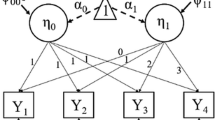Abstract
This paper presents a latent variable approach for the estimation of treatment effects within a pooled interrupted time series (ITS) design. Although considered quasi-experimental, the ITS design has been noted as representing one of the strongest alternatives to the randomized experiment, making it highly appropriate for use in documenting the presence of effects that might warrant further evaluation in a large-scale randomized study. Results suggest that the latent variable growth modeling (LGM) is capable of detecting simultaneous differences in both level and slope, and provides tests of significance for these two necessary indicators of an ITS intervention effect. As shown in the analyses, the LGM framework provides a comprehensive and flexible approach to research design and data analysis, making available to a wide audience of researchers an analytical framework for a variety of analyses of growth and developmental processes.
Similar content being viewed by others
REFERENCES
Biglan, A., Ary, D., & Wagenaar, A. C. (2000). The value of interrupted time-series experiments for community intervention research. Prevention Science, 1,31–47.
Collins, L., & Sayer, J. L. (2001). New methods for the analysis of change. Washington, DC: American Psychological Association.
Cook, T. D., & Campbell, D. T. (1979). Quasi-experiments: Interrupted time-series designs in Quasi-experimentation. Design and analysis issues for field settings. Boston, MA: Houghton Mifflin.
Duncan, T. E., Duncan, S. C., Strycker, L. A., Li, F., & Alpert, A. (1999). An introduction to latent variable growth curve modeling: Concepts, issues, and applications. Mahwah, NJ: Erlbaum.
Duncan, T. E., Duncan, S. C., Strycker, L. A., & Li, F. (2002). A latent variable framework for power estimation and analyses within intervention contexts. Journal of Psychopathology and Behavioral Assessment, 24,1–12.
Duncan, T. E., & Stoolmiller, M. (1993). Modeling social and psycho-logical determinants of exercise behaviors via structural equation systems. Research Quarterly for Exercise and Sport, 64,1–16.
Elliott, D. (1976). National Youth Survey [United States]: Wave 1 [ICPSR version, Computer file], (1976). Boulder, CO: University of Colorado, Behavioral Research Institute [producer], (1977). Ann Arbor, MI: Inter-University Consortium for Political and Social Research [distributor], (1994).
Hawkins, J. D., Lishner, D. M., & Catalano, R. F. (1987). Childhood predictors and the prevention of adolescent substance Abuse. National Institute on Drug Abuse Monographs 56 (DHHS Pub-lication No. ADM 87-1335, pp. 75–126). Washington, DC: U. S. Government Printing Office.
Kessler, R. C., & Greenberg, D. F. (1981).Linear panel analy-sis: Models of quantitative change. New York: Academic Press.
Moore, K. J., Osgood, W., Larzelere, R. E., & Chamberlin, P. (1994). Use of pooled time series in the study of naturally occurring clinical events and problem behavior in a foster care setting. Journal of Consulting and Clinical Psychology, 62,718–728.
Muthén, B. O., & Curran, P. J. (1997). General longitudinal modeling of individual differences in experimental designs: A latent variable framework for analysis and power estimation. Psychological Methods, 2,371–402.
Muthén, L. K., & Muthén, B. O. (1998). Mplus:User's guide. Los Angeles: Authors.
Muthén, L. K., & Muthén, B. O. (2002). How to use a Monte Carlo study to decide on sample size and determine power. Structural Equation Modeling, 4,599–620.
National Institute on Drug Abuse, U.S. Department of Health and Human Services (2000). National Household Survey on Drug Abuse. Washington, DC: Author
Steinberg, L. (1991). Adolescent transitions and alcohol and other drug use prevention. Preventing adolescent drug use: From theory to practice. Monograph-8, (pp. 13–51). Washington, DC: U. S. Department of Health and Human Services, Office of Substance Abuse Prevention.
Velicer, W. F., &Colby, S. M. (1997). Time series analysis for prevention and treatment research. In K. J. Bryant, M. Windle, & S. G. West (Eds.), The science of prevention: methodological advances from alcohol and substance abuse research (pp. 211–249). Washington, DC: American Psychological Association.
Velicer, W. F., & Fava, J. L. (2003). Time series analysis. In J. Schinka & W. F. Velicer (Eds.), Research methods in psychology (pp. 581–606). New York: Wiley.
West, S. G., Biesanz, J. C., & Pitts, S. C. (2000). Causal inference and generalization in field settings: Experimental and quasi-experimental designs. In H. T. Reis & C. M. Judd (Eds.), Handbook of research methods in personality and social psychology.New York: Cambridge University Press.
Author information
Authors and Affiliations
Rights and permissions
About this article
Cite this article
Duncan, T.E., Duncan, S.C. A Latent Growth Curve Modeling Approach to Pooled Interrupted Time Series Analyses. Journal of Psychopathology and Behavioral Assessment 26, 271–278 (2004). https://doi.org/10.1023/B:JOBA.0000045342.32739.2f
Issue Date:
DOI: https://doi.org/10.1023/B:JOBA.0000045342.32739.2f




